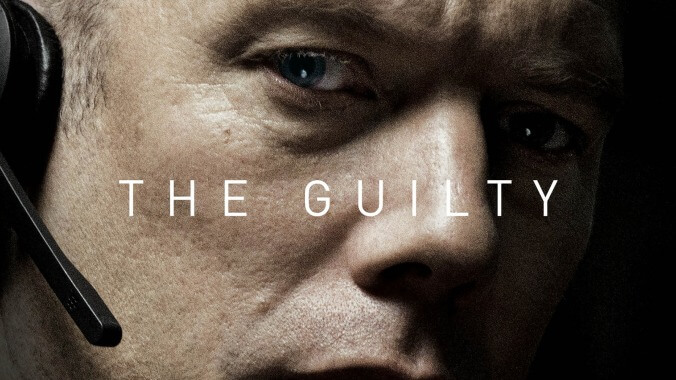One-man show The Guilty effectively transfers Rear Window to a police call center

Stories confined to a single location had a special place in the career of Alfred Hitchcock, who saw them as opportunities to experiment: with long takes in Rope, 3D in Dial M For Murder, and studios sets in Lifeboat and Rear Window, one of his celebrated and most imitated films. But one wonders what the master of suspense would have made of the Danish emergency call center that provides the backdrop for Gustav Möller’s intriguing thriller The Guilty. A utilitarian bullpen with six desks and a water cooler, the setting of Möller’s debut feature is distinctly awkward and uncinematic—a ploy to get us into the point of view of Asger Holm (Jakob Cedergren), a disillusioned Copenhagen narcotics officer who has been reassigned to dispatch until a high-profile internal investigation blows over.
Yes, it’s a variation on Rear Window, with the protagonist bound to a phone line instead of a wheelchair. (Hitchcock himself entertained the idea of making a thriller centered on a phone in the 1960s—an idea that evolved decades later into the 2003 film Phone Booth.) But Asger’s voyeurism is less ambiguous than that of L.B. Jeffries, the photographer played by Jimmy Stewart. Aside from a handful of dispatchers with whom he shares only a few lines of dialogue, he is the sole on-screen character in The Guilty, which unfolds in real time the night before a hearing where he is due to testify. Although the circumstances of his reassignment remain unclear until the end of the film, it’s obvious that he’s itching to get back on the street; he wears his headset like a cone collar.
Until, that is, he takes a call from Iben (Jessica Dinnage), a young mother who appears to have been kidnapped by her ex-husband, Michael (Johan Olsen), a convicted felon. With only a ping off a cell tower near a highway to go off, Asger jumps into action—though, unlike Halle Berry’s character in the similarly premised The Call, he never leaves the call center. (The most he does is change desks to a darker, more private corner of the drab office.) Möller opens The Guilty with its tightest close-up—a languid zoom out from Asger’s ear—and ends it with its only head-to-toe wide shot; in between, he keeps his handheld camera on Asger’s face and on Cedergren’s performance, letting everything else play out in the mind’s eye of the audience. Iben’s abduction seems to have reawakened the officer’s sense of duty. Or is it some latent guilt about the events that landed him behind the desk in the first place?
To get into further detail would involve spoiling The Guilty; Möller’s handling of exposition and plot delivery is most of the show, translated into careful, tinnily crackling sound design as Asger tries to figure out what’s going on (and where Michael might be headed) from behind a desk, overstepping more than his share of bounds along the way. The viewer’s ability to follow a movie with the sound off is seen as proof of a director’s skill, but The Guilty, which could easily be a radio play or podcast, displays obvious talent on Möller’s part—from his direction of the large, unseen supporting cast to the background noise of sloshing tires and drumming rain that evokes both an unseen rainstorm and Asger’s own internal tumult. It might not be the kind of movie that anyone needs to see twice, but its variations on the classic building blocks of suspense implicate our own guesswork in interesting ways—suggesting, in a roundabout manner, that the qualities that make Asger a driven protagonist might make him a less than ideal officer of the law. To that extent, it has something to offer even those viewers who are sick of stories about dirty cops in need of redemption.